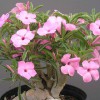 Adenium swazicum is a species of desert rose whose gray-green leaves appear folded and are velvety to touch. It is sought after by collectors for its graceful, weeping branches and delicate flowers that occur in various shades of pink. It is a smaller plant with weaker branches and stems compared to other Adenium species such as Adenium obesum or Adenium arabicum. This 2-page fact sheet was written by R.J. Henny and J. Chen, and published by the UF Department of Environmental Horticulture, April 2014.
Adenium swazicum is a species of desert rose whose gray-green leaves appear folded and are velvety to touch. It is sought after by collectors for its graceful, weeping branches and delicate flowers that occur in various shades of pink. It is a smaller plant with weaker branches and stems compared to other Adenium species such as Adenium obesum or Adenium arabicum. This 2-page fact sheet was written by R.J. Henny and J. Chen, and published by the UF Department of Environmental Horticulture, April 2014.
http://edis.ifas.ufl.edu/ep499
Tag: Environmental Horticulture Department
Managing Mexican Petunia (Ruellia simplex C. Wright) in the Home Landscape
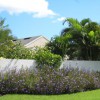 Environmental tolerance, abundant seed production, and an ability to easily grow from plant stem sections have allowed Mexican petunia to spread into natural areas that border urban areas. The Florida Exotic Pest Plant Council lists Mexican petunia (wild-type and non-sterile cultivars) as a Category 1 invasive species, meaning that it is “altering native plant communities by displacing native species, changing community structures or ecological functions, or hybridizing with natives”. These potential changes to community structure and ecological function are of particular concern in Florida wetlands, where changes to plant communities have the potential to impact not just plant-animal interactions, but also overall hydrology on a whole watershed level. This 6-page fact sheet was written by C. A. Reinhardt Adams, C. Wiese, L.C. Lee, S.B. Wilson, A. M. Smith, and R. Freyre, and published by the UF Department of Environmental Horticulture, April 2014.
Environmental tolerance, abundant seed production, and an ability to easily grow from plant stem sections have allowed Mexican petunia to spread into natural areas that border urban areas. The Florida Exotic Pest Plant Council lists Mexican petunia (wild-type and non-sterile cultivars) as a Category 1 invasive species, meaning that it is “altering native plant communities by displacing native species, changing community structures or ecological functions, or hybridizing with natives”. These potential changes to community structure and ecological function are of particular concern in Florida wetlands, where changes to plant communities have the potential to impact not just plant-animal interactions, but also overall hydrology on a whole watershed level. This 6-page fact sheet was written by C. A. Reinhardt Adams, C. Wiese, L.C. Lee, S.B. Wilson, A. M. Smith, and R. Freyre, and published by the UF Department of Environmental Horticulture, April 2014.
http://edis.ifas.ufl.edu/ep498
Violet Biology and Management in Turf
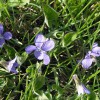 Violets (Viola spp.) are diverse winter annuals and perennials. Perennials form rhizomes or long stolons. Many have heart-shaped leaves on long petioles and have a rosette growth habit. Some have linear leaves and others have palmate leaves. Flowers are generally purple, but can be white, pink or yellow. They reproduce by seed or, when produced, rhizomes. This 2-page fact sheet was written by Darcy E. P. Telenko, Barry J. Brecke, Ramon Leon, and J. Bryan Unruh, and published by the UF Department of Environmental Horticulture, December 2013.
Violets (Viola spp.) are diverse winter annuals and perennials. Perennials form rhizomes or long stolons. Many have heart-shaped leaves on long petioles and have a rosette growth habit. Some have linear leaves and others have palmate leaves. Flowers are generally purple, but can be white, pink or yellow. They reproduce by seed or, when produced, rhizomes. This 2-page fact sheet was written by Darcy E. P. Telenko, Barry J. Brecke, Ramon Leon, and J. Bryan Unruh, and published by the UF Department of Environmental Horticulture, December 2013.
http://edis.ifas.ufl.edu/ep496
Spreading Dayflower Biology and Management in Turf
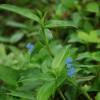 Spreading dayflower (Commelina diffusa) is a succulent annual that produces freely branched smooth stems. Leaves are broadly lance-shaped with closed sheaths. Sheaths are short with a few soft hairs on the upper margin. Flowers have three blue petals in a leaf-like structure open on the margins. Reproduction occurs via seed and stem fragments. This 2-page fact sheet was written by J. Bryan Unruh, Darcy E. P. Telenko, Barry J. Brecke, and Ramon Leon, and published by the UF Department of Environmental Horticulture, December 2013.
Spreading dayflower (Commelina diffusa) is a succulent annual that produces freely branched smooth stems. Leaves are broadly lance-shaped with closed sheaths. Sheaths are short with a few soft hairs on the upper margin. Flowers have three blue petals in a leaf-like structure open on the margins. Reproduction occurs via seed and stem fragments. This 2-page fact sheet was written by J. Bryan Unruh, Darcy E. P. Telenko, Barry J. Brecke, and Ramon Leon, and published by the UF Department of Environmental Horticulture, December 2013.
http://edis.ifas.ufl.edu/ep497
Livistona chinensis: Chinese Fan Palm
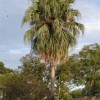 The Chinese fan palm is relatively slow growing, typically reaching about 30 feet in height. Its fan-shaped, costapalmate leaves can be 3 to 4 feet across and up to 6 feet long. Petioles of juvenile palms are spiny, but have few or no spines in adult palms. Because of its gracefully drooping leaf segment tips, this species is sometimes called the “fountain palm”. Young specimens are slow to form a trunk, which has led to the unfortunate practice of planting these palms close together as a ground cover. Eventually, most of those closely planted palms will have to be removed to accommodate their 10 to 12 foot spread. This 5-page fact sheet was written by Timothy K. Broschat, and published by the UF Department of Environmental Horticulture, April 2014.
The Chinese fan palm is relatively slow growing, typically reaching about 30 feet in height. Its fan-shaped, costapalmate leaves can be 3 to 4 feet across and up to 6 feet long. Petioles of juvenile palms are spiny, but have few or no spines in adult palms. Because of its gracefully drooping leaf segment tips, this species is sometimes called the “fountain palm”. Young specimens are slow to form a trunk, which has led to the unfortunate practice of planting these palms close together as a ground cover. Eventually, most of those closely planted palms will have to be removed to accommodate their 10 to 12 foot spread. This 5-page fact sheet was written by Timothy K. Broschat, and published by the UF Department of Environmental Horticulture, April 2014.
http://edis.ifas.ufl.edu/st365
Roystonea regia: Royal Palm
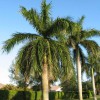 The royal palm is a large majestic palm that is native to south Florida and Cuba. It is considered cold hardy to about 28°F or USDA Cold Hardiness Zone 10A. This species quickly grows to heights of 50–70 ft., with a spread of 20–25 ft., and has a smooth light gray trunk up to 2 ft. in diameter. It is ideal for landscaping streets, parks, and commercial properties, but becomes too large for typical residential landscapes. This 4-page fact sheet was written by T.K. Broschat, and published by the UF Department of Environmental Horticulture, February 2014.
The royal palm is a large majestic palm that is native to south Florida and Cuba. It is considered cold hardy to about 28°F or USDA Cold Hardiness Zone 10A. This species quickly grows to heights of 50–70 ft., with a spread of 20–25 ft., and has a smooth light gray trunk up to 2 ft. in diameter. It is ideal for landscaping streets, parks, and commercial properties, but becomes too large for typical residential landscapes. This 4-page fact sheet was written by T.K. Broschat, and published by the UF Department of Environmental Horticulture, February 2014.
http://edis.ifas.ufl.edu/st574
Black Medic Biology and Management in Turf
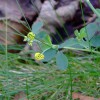 Black medic (Medicago lupulina) is a dark green annual with spreading, prostrate growth. Leaves are alternate with three leaflets on square stems. Leaflets are obovate to elliptic, toothed near the tip, and have a small spur on the tip. Bright yellow flowers are produced in tight, compressed clusters at leaf axils. Reproduction occurs via seed in tightly coiled black seed pods. This 2-page fact sheet was written by Barry J. Brecke, Ramon Leon, J. Bryan Unruh, and Darcy E. P. Telenko, and published by the UF Department of Environmental Horticulture, December 2014.
Black medic (Medicago lupulina) is a dark green annual with spreading, prostrate growth. Leaves are alternate with three leaflets on square stems. Leaflets are obovate to elliptic, toothed near the tip, and have a small spur on the tip. Bright yellow flowers are produced in tight, compressed clusters at leaf axils. Reproduction occurs via seed in tightly coiled black seed pods. This 2-page fact sheet was written by Barry J. Brecke, Ramon Leon, J. Bryan Unruh, and Darcy E. P. Telenko, and published by the UF Department of Environmental Horticulture, December 2014.
http://edis.ifas.ufl.edu/ep494
Sedge Biology and Management in Turf
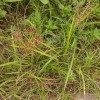 Members of the sedge family have leaves that are composed of a blade, sheath, and ligule. The leaf sheath is closed and the ligule is often absent, and when present is tiny. Stem structure is often triangular.This 3-page fact sheet was written by D. E. P. Telenko, Ramon Leon, J. Bryan Unruh, and B. J. Brecke, and published by the UF Department of Environmental Horticulture, December 2014.
Members of the sedge family have leaves that are composed of a blade, sheath, and ligule. The leaf sheath is closed and the ligule is often absent, and when present is tiny. Stem structure is often triangular.This 3-page fact sheet was written by D. E. P. Telenko, Ramon Leon, J. Bryan Unruh, and B. J. Brecke, and published by the UF Department of Environmental Horticulture, December 2014.
http://edis.ifas.ufl.edu/ep492
Old World Diamond-Flower Biology and Management in Turf
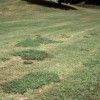 Old world diamond-flower is a smooth, spreading summer annual. It has branched stems with opposite, narrow leaves. Flowers are white, usually with two or more on long stalks extending from the tip of a common long stalk. Flowers occur from midsummer until frost. Reproduction occurs by seed. Found in moist areas, especially areas that have been disturbed. This 2-page fact sheet was written by Darcy E. P. Telenko, Barry J. Brecke, Ramon Leon, and J. Bryan Unruh, and published by the UF Department of Environmental Horticulture, December 2013.
Old world diamond-flower is a smooth, spreading summer annual. It has branched stems with opposite, narrow leaves. Flowers are white, usually with two or more on long stalks extending from the tip of a common long stalk. Flowers occur from midsummer until frost. Reproduction occurs by seed. Found in moist areas, especially areas that have been disturbed. This 2-page fact sheet was written by Darcy E. P. Telenko, Barry J. Brecke, Ramon Leon, and J. Bryan Unruh, and published by the UF Department of Environmental Horticulture, December 2013.
http://edis.ifas.ufl.edu/ep493
Plumeria: Propagation from Cuttings
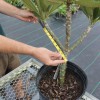 Plumeria are flowering ornamentals native to the Caribbean, Mexico, Central America, Venezuela, and Colombia. Highly valued for their colorful flowers, plumeria are now grown in tropical and subtropical areas throughout the world. Plumeria, or frangipani, are members of the Apocynaceae family. Unless steps are taken to prevent frost damage, plumeria are generally limited to landscape uses in south Florida and protected regions of central Florida. This 5-page fact sheet was written by Andrew K. Koeser, Gitta Hasing, and Drew McLean, and published by the UF Department of Environmental Horticulture, October 2013.
Plumeria are flowering ornamentals native to the Caribbean, Mexico, Central America, Venezuela, and Colombia. Highly valued for their colorful flowers, plumeria are now grown in tropical and subtropical areas throughout the world. Plumeria, or frangipani, are members of the Apocynaceae family. Unless steps are taken to prevent frost damage, plumeria are generally limited to landscape uses in south Florida and protected regions of central Florida. This 5-page fact sheet was written by Andrew K. Koeser, Gitta Hasing, and Drew McLean, and published by the UF Department of Environmental Horticulture, October 2013.
http://edis.ifas.ufl.edu/ep489
Erect and Prostrate Spurge Biology and Management in Turf
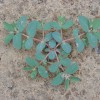 Erect and prostrate spurges are erect or upright annuals with branched stems. Leaves are opposite and not equal. Stems produce “milky sap.” A large number of spurge species occur in Florida. Reproduction occurs via seed. This 2-page fact sheet was written by J. Bryan Unruh, Darcy E. P. Telenko, Barry J. Brecke, and Ramon Leon, and published by the UF Department of Environmental Horticulture, December 2013.
Erect and prostrate spurges are erect or upright annuals with branched stems. Leaves are opposite and not equal. Stems produce “milky sap.” A large number of spurge species occur in Florida. Reproduction occurs via seed. This 2-page fact sheet was written by J. Bryan Unruh, Darcy E. P. Telenko, Barry J. Brecke, and Ramon Leon, and published by the UF Department of Environmental Horticulture, December 2013.
http://edis.ifas.ufl.edu/ep495
Tree Risk Assessment Methods: A Comparison of Three Common Evaluation Forms
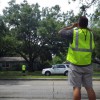 All trees pose some level of risk to nearby people, structures, and utilities. As trees age or become weakened by pests, disease, and/or other stresses, a tree owner or manager may need to decide what risk level he or she is willing to accept and what modifications may be needed. Experienced arborists can aid in this decision process by conducting a professional risk assessment that specifies the likelihood of whole or partial tree failure, the consequences of such a failure, and the potential targets affected. A variety of risk assessment methods have been developed to guide professionals through the tree inspection process. In North America, three risk assessment methods have gained the greatest acceptance among tree care professionals, municipal urban forestry programs, and government agencies. This 8-page fact sheet was written by Andrew K. Koeser, Gitta Hasing, Drew McLean, and Rob Northrop, and published by the UF Department of Environmental Horticulture, November 2013.
All trees pose some level of risk to nearby people, structures, and utilities. As trees age or become weakened by pests, disease, and/or other stresses, a tree owner or manager may need to decide what risk level he or she is willing to accept and what modifications may be needed. Experienced arborists can aid in this decision process by conducting a professional risk assessment that specifies the likelihood of whole or partial tree failure, the consequences of such a failure, and the potential targets affected. A variety of risk assessment methods have been developed to guide professionals through the tree inspection process. In North America, three risk assessment methods have gained the greatest acceptance among tree care professionals, municipal urban forestry programs, and government agencies. This 8-page fact sheet was written by Andrew K. Koeser, Gitta Hasing, Drew McLean, and Rob Northrop, and published by the UF Department of Environmental Horticulture, November 2013.
http://edis.ifas.ufl.edu/ep487
Faber’s Maple: Acer fabri
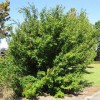 Faber's Maple is unlike the maples familiar to most people, as it does not have the typical three- or five-lobed leaves. Instead, the leaves of Faber's maple are unlobed, slender, and very glossy. Additionally, most people know the maple as a deciduous tree, dropping its leaves in fall, whereas Faber's maple is evergreen. This 2-page fact sheet was written by Gary W. Knox, and published by the UF Department of Environmental Horticulture, December 2013.
Faber's Maple is unlike the maples familiar to most people, as it does not have the typical three- or five-lobed leaves. Instead, the leaves of Faber's maple are unlobed, slender, and very glossy. Additionally, most people know the maple as a deciduous tree, dropping its leaves in fall, whereas Faber's maple is evergreen. This 2-page fact sheet was written by Gary W. Knox, and published by the UF Department of Environmental Horticulture, December 2013.
http://edis.ifas.ufl.edu/ep490
Apalachee Crapemyrtle: Lagerstroemia indica × fauriei 'Apalachee'
 ‘Apalachee’ crapemyrtle is a small deciduous tree with lavender flowers, dark green leaves, and cinnamon-orange bark. Lagerstroemia indica x fauriei ‘Apalachee’ is one of the hybrids released in 1987 from the breeding program of the U.S. National Arboretum. It grows as an upright to vase-shaped multi-stemmed tree in USDA Cold Hardiness Zones 7a-9b. This 2-page fact sheet was written by Gary W. Knox, and published by the UF Department of Environmental Horticulture, December 2014.
‘Apalachee’ crapemyrtle is a small deciduous tree with lavender flowers, dark green leaves, and cinnamon-orange bark. Lagerstroemia indica x fauriei ‘Apalachee’ is one of the hybrids released in 1987 from the breeding program of the U.S. National Arboretum. It grows as an upright to vase-shaped multi-stemmed tree in USDA Cold Hardiness Zones 7a-9b. This 2-page fact sheet was written by Gary W. Knox, and published by the UF Department of Environmental Horticulture, December 2014.
http://edis.ifas.ufl.edu/ep491
Drying and Preserving Plant Materials for Decorative Uses
 Dried and preserved plant materials are popular for home decor. Dried arrangements can preserve the graceful lines, textures, and colors of flowers and foliage with a subtle and gently aged appearance. This 14-page fact sheet was written by Sydney Park Brown, Patricia White, Benny Tjia, Marion R. Sheehan, and published by the UF Department of Environmental Horticulture, November 2013.
Dried and preserved plant materials are popular for home decor. Dried arrangements can preserve the graceful lines, textures, and colors of flowers and foliage with a subtle and gently aged appearance. This 14-page fact sheet was written by Sydney Park Brown, Patricia White, Benny Tjia, Marion R. Sheehan, and published by the UF Department of Environmental Horticulture, November 2013.
http://edis.ifas.ufl.edu/ep004
Seed Sources for Florida Home-grown Vegetables
 The right vegetable varieties can make a big difference in the success of a home vegetable garden. Although a huge selection of seeds and transplants are available through garden centers, seed catalogs, and the internet, choosing what to buy can be confusing. Some of the best varieties for Florida gardens and seed suppliers that currently sell them are listed in this 6-page fact sheet written by Ed Thralls, Sydney Park Brown, and Ed Paulson, and published by the UF Department of Environmental Horticulture, November 2013.
The right vegetable varieties can make a big difference in the success of a home vegetable garden. Although a huge selection of seeds and transplants are available through garden centers, seed catalogs, and the internet, choosing what to buy can be confusing. Some of the best varieties for Florida gardens and seed suppliers that currently sell them are listed in this 6-page fact sheet written by Ed Thralls, Sydney Park Brown, and Ed Paulson, and published by the UF Department of Environmental Horticulture, November 2013.
http://edis.ifas.ufl.edu/ep486
Alternatives to Invasive Plants Commonly Found in South Florida Landscapes
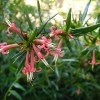 Based on years of UF/IFAS research producing and trialing cultivars, this 5-page fact sheet lists native and non-invasive, non-native ornamentals as alternatives to invasive plants commonly used in Florida landscapes. Only plants considered to be generally available in the nursery trade are listed. Alternative plants are similar to respective invasive plants as much as possible in terms of size, habit, texture, and flower color. Written by Gary W. Knox, Sandra B. Wilson, Zhanao Deng, and Rosanna Freyre, and published by the UF Department of Environmental Horticulture, September 2013.
Based on years of UF/IFAS research producing and trialing cultivars, this 5-page fact sheet lists native and non-invasive, non-native ornamentals as alternatives to invasive plants commonly used in Florida landscapes. Only plants considered to be generally available in the nursery trade are listed. Alternative plants are similar to respective invasive plants as much as possible in terms of size, habit, texture, and flower color. Written by Gary W. Knox, Sandra B. Wilson, Zhanao Deng, and Rosanna Freyre, and published by the UF Department of Environmental Horticulture, September 2013.
http://edis.ifas.ufl.edu/ep483
Spanish Moss, Ball Moss, and Lichens – Harmless Epiphytes
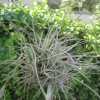 Epiphytes are “air” plants that survive on moisture and nutrients in the atmosphere. Several epiphytic plants, like Spanish moss, ball moss, and lichen, are common to the Florida landscape and southeast United States. People unfamiliar with epiphytes sometimes worry that they may cause injuries to the plants they perch in. Epiphytes do attach themselves to plants, but they do not harm the plants, unlike mistletoe, a plant parasite. Without soil as a source of nutrients, epiphytic plants have evolved the capacity to obtain minerals dissolved in water that flows across leaves and down branches. This 3-page fact sheet was written by Joe Sewards and Sydney Park Brown, and published by the UF Department of Environmental Horticulture, September 2013.
Epiphytes are “air” plants that survive on moisture and nutrients in the atmosphere. Several epiphytic plants, like Spanish moss, ball moss, and lichen, are common to the Florida landscape and southeast United States. People unfamiliar with epiphytes sometimes worry that they may cause injuries to the plants they perch in. Epiphytes do attach themselves to plants, but they do not harm the plants, unlike mistletoe, a plant parasite. Without soil as a source of nutrients, epiphytic plants have evolved the capacity to obtain minerals dissolved in water that flows across leaves and down branches. This 3-page fact sheet was written by Joe Sewards and Sydney Park Brown, and published by the UF Department of Environmental Horticulture, September 2013.
http://edis.ifas.ufl.edu/ep485
Washingtonia robusta: Mexican Fan Palm
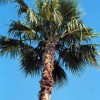 The Mexican fan palm is a fast-growing species that can reach heights of 70 to 100 feet, making it too tall for typical residential landscapes. It is native to northern Mexico but grows well in Florida, being hardy down to about 20°F or USDA hardiness zone 9A. Mexican fan palms grow well in a wide range of soils in Florida, but do require good drainage. Though considered a desert palm, it is native to areas having permanent surface or subsurface water and thus is not as drought tolerant as might be expected. This 5-page fact sheet was written by Timothy K. Broschat, and published by the UF Department of Environmental Horticulture, February 2013.
The Mexican fan palm is a fast-growing species that can reach heights of 70 to 100 feet, making it too tall for typical residential landscapes. It is native to northern Mexico but grows well in Florida, being hardy down to about 20°F or USDA hardiness zone 9A. Mexican fan palms grow well in a wide range of soils in Florida, but do require good drainage. Though considered a desert palm, it is native to areas having permanent surface or subsurface water and thus is not as drought tolerant as might be expected. This 5-page fact sheet was written by Timothy K. Broschat, and published by the UF Department of Environmental Horticulture, February 2013.
http://edis.ifas.ufl.edu/st670
Syagrus romanzoffiana: Queen Palm
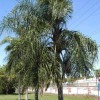 The queen palm is a popular feather-leaved palm with graceful arching leaves. It is one of the hardiest of the tropical-looking palms, being suitable for planting in USDA plant hardiness zone 9B (>25°F). Queen palms are considered to be moderately tolerant of salt spray. This 5-page fact sheet was written by Timothy K. Broschat, and published by the UF Department of Environmental Horticulture, October 2013.
The queen palm is a popular feather-leaved palm with graceful arching leaves. It is one of the hardiest of the tropical-looking palms, being suitable for planting in USDA plant hardiness zone 9B (>25°F). Queen palms are considered to be moderately tolerant of salt spray. This 5-page fact sheet was written by Timothy K. Broschat, and published by the UF Department of Environmental Horticulture, October 2013.
http://edis.ifas.ufl.edu/st609